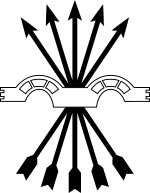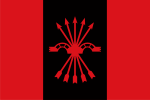Falange Española de las JONS facts for kids
Quick facts for kids
Spanish Falange of the Councils of the National Syndicalist Offensive
Falange Española de las Juntas de Ofensiva Nacional Sindicalista
|
|
|---|---|
 |
|
| National Chief | José Antonio Primo de Rivera (first) Manuel Hedilla (last) |
| Founders | José Antonio Primo de Rivera Ramiro Ledesma Onésimo Redondo |
| Founded | 4 March 1934 |
| Dissolved | 19 April 1937 |
| Preceded by | Falange Española JONS |
| Merged into | FET y de las JONS |
| Headquarters | Madrid, Spain |
| Newspaper | Diario Arriba |
| Student wing | Sindicato Español Universitario |
| Women's wing | Sección Femenina |
| Urban militia | Falange de Sangre/Primera Línea |
| Labor wing | National-Syndicalist Workers Central |
| Ideology | Fascism Falangism |
| Political position | Far-right |
| Anthem | Cara al Sol |
| Party flag | |
 |
|
The Falange Española de las Juntas de Ofensiva Nacional Sindicalista (FE de las JONS) was a political party in Spain. It was formed in 1934 when two groups, the Falange Española and the Juntas de Ofensiva Nacional-Sindicalista, joined together. This party became the main group in Spain that followed a political idea called fascism.
The FE de las JONS stopped existing as a separate party in April 1937. This happened during the Spanish Civil War when General Francisco Franco combined it with another group, the Traditionalist Communion. The new, larger party was called Falange Española Tradicionalista y de las JONS.
Contents
What Was the Falange?
The Falange was a political group in Spain during the 1930s. It had strong ideas about Spanish nationalism and wanted to create a new kind of society. They believed in a strong government and a united Spain.
How the Party Started
In 1934, the Falange Española joined with the Juntas de Ofensiva Nacional-Sindicalista (JONS). This created the 'Falange Española de las Juntas de Ofensiva Nacional Sindicalista'. Key leaders were José Antonio Primo de Rivera, Onésimo Redondo, and Ramiro Ledesma.
There were often conflicts between members of the Falange and other political groups. These clashes sometimes led to violence. The Falange also formed its own groups to respond to these conflicts.
Early Leaders and Ideas
The party was first led by a group of three: Ramiro Ledesma, Ruiz de Alda, and José Antonio Primo de Rivera. Many smart people, including writers and thinkers, joined the Falange.
The Falange had different ideas within the party. Some members were more traditional, while others wanted big changes. For example, some were strong Catholics, and others wanted the government and church to be separate.
In October 1934, José Antonio Primo de Rivera became the main leader. The party then created a set of political goals called "the 27 Points."
Challenges and Changes
The Falange faced money problems early on. It also had disagreements among its leaders. Ramiro Ledesma, who wanted more radical changes, left the party in January 1935.
The party received some financial help from the Italian Fascist government. However, this support decreased after the Falange did not do well in elections.
Political Views and Support
The Falange supported a republic and wanted to help the working class. They were against both very rich powerful groups (oligarchy) and communism. However, they never gained as much public support as similar movements in other European countries.
In the 1936 Spanish general election, the Falange received very few votes. They did not win any seats in the Spanish parliament. They had fewer than ten thousand members before the Civil War.
The Falange believed in some social and economic reforms. They wanted to help poor farmers and workers. They thought that conflicts between different social classes could be solved by uniting everyone under the Falange's ideas. They hoped this would make Spain strong again.
Party Groups and Training
The Falange had a group of members who received military training. This group was called the Primera Línea. They also had an intelligence service.
The party had a women's group called the Sección Femenina. This group was led by José Antonio's sister, Pilar Primo de Rivera. The women's section helped the party by raising money and sharing information, especially when the party faced difficulties.
Growing Tensions
After the 1936 elections, conflicts between the Falange and other groups increased. Many Falangist members were killed. In response, the Falange also carried out attacks.
The government began to take action against the Falange. Its leader, José Antonio Primo de Rivera, was arrested in July 1936. The Falange then joined a plan to overthrow the government, supporting the military uprising led by Francisco Franco. This led to the Spanish Civil War.
The Falange During the Civil War
When the Civil War began in July 1936, the Falange fought alongside the Nationalist side against the government. Many people joined the Falange during this time, and its membership grew very quickly.
José Antonio Primo de Rivera, the co-founder, was in prison when the war started. He was later executed in November 1936, becoming a hero for the Falangists.
Manuel Hedilla became the leader of the Falange after many original leaders were killed or imprisoned. Hedilla played a role in securing the town of Corunna for the Nationalists. He also spoke out against some of the harsh actions taken during the war.
Unification Under Franco
On April 19, 1937, General Francisco Franco took control. He combined the Falange with another group called the Comunión Tradicionalista (Carlists). This new party was named Falange Española Tradicionalista y de las JONS (FET y de las JONS).
Franco wanted to unite all nationalist groups under his command. The new party's main ideas were based on the Falange's "27 points," which were reduced to 26. The uniform for the new party combined elements from both groups: the Carlist red beret and the Falangist blue shirt.
Many members of the original Falange and Carlists did not join this new unified party. However, Franco's goal was to have a single, strong political force.
The Falange suffered many losses during the war. A large percentage of its pre-war members died. After the war, the new party, FET y de las JONS, gained control of the property of other political parties and worker unions. By 1938, all worker unions were under the control of this new Falangist-led party.
Images for kids
-
Militias of the Falange in Saragossa, October 1936
-
The swan, symbol of Ximenez de Cisneros, also symbol of the Frente de Juventudes.
See also
 In Spanish: Falange Española de las JONS para niños
In Spanish: Falange Española de las JONS para niños



